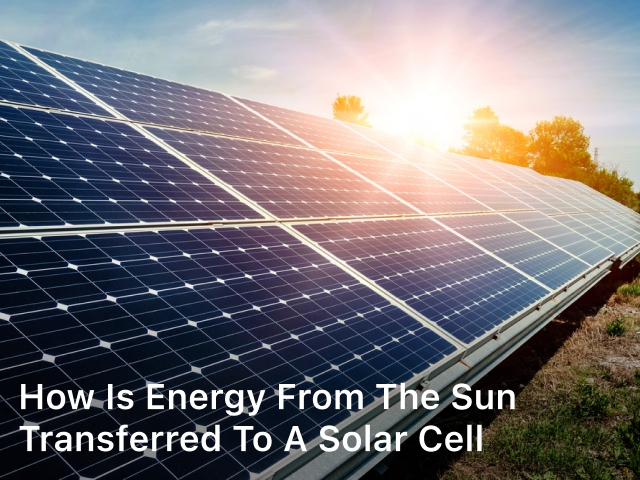
greentechinnovate.com.How is Energy from The Sun Transferred to a Solar Cell – Discover the fascinating process of how energy from the sun is transferred and harnessed to solar cells. Explore the key steps involved in converting sunlight into usable electricity.
In an era where sustainable energy sources are gaining paramount importance, solar power stands as one of the most promising solutions. At the heart of this renewable energy revolution lies the mechanism of transferring energy from the sun to solar cells.
This intricate process involves several steps that culminate in the generation of clean and efficient electricity. In this article, we delve into the details of how energy from the sun is transferred to a solar cell, demystifying the science and technology behind this eco-friendly energy generation method.
How is Energy from The Sun Transferred to a Solar Cell?
Harnessing solar energy and converting it into electricity involves a captivating dance of photons, semiconductors, and electrical currents. Let’s unravel the process step by step:
Absorption of Sunlight
The journey begins with the sun emitting an incessant stream of photons, the fundamental particles of light. As these photons travel through space and reach the Earth’s atmosphere, they interact with the surface of solar panels. The solar panels are equipped with specially designed materials known as semiconductors, usually made from silicon.
Generation of Electron-Hole Pairs
Upon interaction with the semiconductors, the photons transfer their energy to the atoms within the material. This energy infusion propels electrons to higher energy levels, leaving behind “holes” in their original positions. This exciting of electrons creates what is known as electron-hole pairs.

Facilitation of Electron Flow
The next stage involves the movement of these electron-hole pairs. The semiconductor’s unique properties enable the separated electrons and holes to move freely.
Due to the electric field present at the junction of different semiconductor layers, electrons are pushed towards the N-type layer, while holes move towards the P-type layer.
Creation of Electrical Current
The movement of electrons and holes in opposite directions generates an electric current. This flow of electrons constitutes the electricity that can be harvested for various applications. The solar cell’s design ensures that this generated electricity is directed to external circuits for utilization.
Inverter Conversion for Practical Use
While the electricity generated is in direct current (DC), most household appliances and the power grid operate on alternating current (AC).
To make the electricity compatible with these applications, an inverter is used to convert DC into AC. This is a crucial step in making the solar-generated energy practical for everyday use.
Understanding the Solar Cell Types
To comprehend how energy from the sun is transferred to solar cells, it’s essential to grasp the different types of solar cells:
Monocrystalline Solar Cells
Monocrystalline solar cells are crafted from a single crystal structure. Their uniform composition allows for higher efficiency in converting sunlight into electricity. These cells are easily recognizable by their dark color and rounded edges.
Polycrystalline Solar Cells
Polycrystalline solar cells are made from multiple crystal structures. Although slightly less efficient than monocrystalline cells, they are more cost-effective to produce. They appear blueish and have a more angular shape.
Thin-Film Solar Cells
Thin-film solar cells are incredibly flexible and lightweight. They are manufactured by depositing thin layers of photovoltaic material onto a substrate. While they are less efficient, they are highly versatile and can be integrated into various surfaces and objects.
Maximizing Solar Energy Efficiency
Enhancing the efficiency of energy transfer from the sun to solar cells is a continuous endeavor. Researchers and engineers are exploring various techniques to optimize this process:
Anti-Reflective Coatings
One challenge in efficient energy absorption is the reflection of sunlight off the surface of solar panels. Anti-reflective coatings are applied to minimize reflection, allowing a higher percentage of photons to be absorbed by the solar cell.
Bifacial Solar Panels
Bifacial solar panels have the remarkable ability to capture sunlight from both sides. This means they can utilize direct sunlight as well as reflected sunlight from surfaces like the ground or nearby buildings. This design increases overall energy generation.
Tracking Systems
Solar panels equipped with tracking systems follow the sun’s path throughout the day, ensuring that they are always positioned at an optimal angle to receive maximum sunlight. This dynamic adjustment significantly enhances energy absorption.
Tandem Solar Cells
Tandem solar cells stack multiple layers of semiconductors with varying absorption properties. This allows them to capture a broader spectrum of light and convert it into electricity, leading to higher efficiency.
FAQs
Q: Are solar cells only effective on sunny days?
A: While solar cells perform best under direct sunlight, they can still generate electricity on cloudy days. Diffuse sunlight can be converted into usable energy, although at a reduced efficiency.
Q: Can I use solar energy at night?
A: Solar panels do not produce electricity at night since there is no sunlight to convert. However, energy generated during the day can be stored in batteries for nighttime use.
Q: How long do solar panels last?
A: Most solar panels come with a warranty of 25 to 30 years, but they can continue to produce electricity beyond that timeframe. Their efficiency might decrease slightly over the years.
Q: Can I install solar panels myself?
A: While it’s possible, it’s recommended to hire a professional installer. Proper installation ensures optimal positioning, wiring, and connection to the electrical system.
Q: What is the environmental impact of solar energy?
A: Solar energy is environmentally friendly, producing no greenhouse gas emissions during operation. The manufacturing process does have some impact, but it is significantly lower than fossil fuel-based power generation.
Q: Are there any government incentives for installing solar panels?
A: Many governments offer incentives such as tax credits, rebates, and grants to encourage the adoption of solar energy. These incentives vary by location.
Conclusion
The process of transferring energy from the sun to a solar cell is a fascinating interplay of physics, materials science, and engineering ingenuity. By understanding this process, we gain insight into how solar power has emerged as a clean, sustainable, and viable energy source for a greener future.




